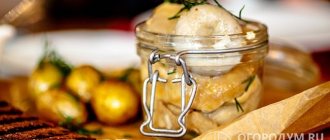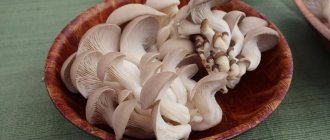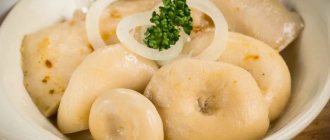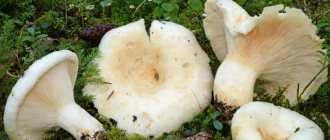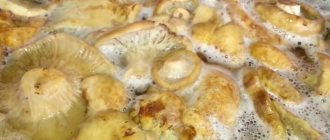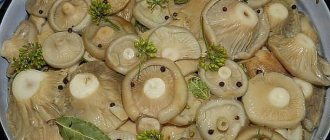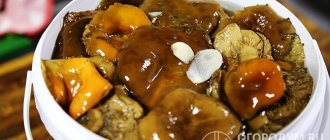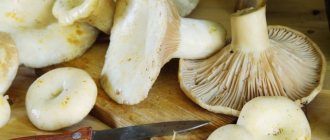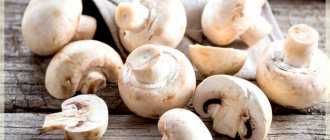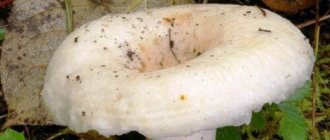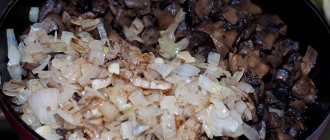The milk mushroom has long been considered the king of mushrooms in Rus' - in its nutritional and taste qualities it surpasses even the famous porcini mushroom, boletus. Fleshy, elastic pulp and a special rich taste make this type of forest gift the best product for pickling.
Find out about the different methods for salting milk mushrooms, how to properly prepare these mushrooms, what you need to take into account so that the preparation comes out aromatic, appetizing and will delight you in the winter.
Secrets of preliminary preparation
Before choosing a way to salt the harvest of milk mushrooms, it is worth learning some of the features and secrets of tasty preparation:
- Fruit bodies should not be wormy or spoiled.
- If there is “rust” on the mushroom, you do not need to use it for pickling.
- The milk mushrooms should definitely be soaked, this will relieve them of their characteristic bitterness. Some experienced lovers of quiet hunting devote 2-3 days to this process, but if there is no time, then 3-4 hours will be enough. Water must be constantly changed and fresh water added.
- For salting, you need to choose the following types of dishes: ceramic, enamel (pan or bucket), glass, wooden barrel. There should be no chips or cracks in the container.
- Each portion of mushrooms that is removed must be washed to get rid of salt and mucus. Then wash the gauze that covers the preservation and re-install the pressure.
- To pickle milk mushrooms, you can use only salt or supplement the preparation with aromatic herbs and spices: dry dill, cherry leaves, currants, horseradish, black and allspice peppers, cloves, garlic.
Milk Gorchak Lactarius Rurus
A mushroom from the genus Milky, the Russula family, also known as Gorkushka and Putik (not in honor of the politician). The word "rufus" in the Latin name means "red-haired". An antibiotic that inhibits the development of Staphylococcus aureus is successfully obtained from this fungus.
Appearance
The cap is dry and fleshy, up to 12 cm in diameter, initially flat-convex, later funnel-shaped, with a tubercle in the middle. The color of the cap varies within dark red or red-brown shades, sometimes with visible lighter concentric zones, its surface is dull-matte and covered with thin grooves.
The hymenophore is lamellar, the plates are frequent and narrow, slightly descending along the stalk, initially reddish-yellow, and later with a whitish tint. The spore powder is whitish.
The leg is up to 10 cm long and up to 2 cm in diameter, cylindrical in shape, with pubescence at the base. The color of the leg changes with age from whitish to pinkish-red. Over time, a cavity forms inside the leg.
The pulp is thin and has a characteristic smell of tree resin. It produces abundant white, burning and acrid milky juice.
Where and when does it grow
Grows from June to the second half of October in moist and acidic soils in mixed and pine forests. Likes to grow surrounded by mosses and lichens. Forms mycorrhiza with birch and coniferous trees. Usually found in large groups. Peak fruiting occurs in August – September.
Culinary use
This mushroom belongs to the conditionally edible category and is edible after long soaking and boiling. It is usually salted or pickled. When salted it turns dark brown.
Getting ready for pickling at home
All known types of milk mushrooms are suitable for pickling: black, yellow, oak and aspen milk mushrooms, white or black milk mushrooms, and the most famous – white milk mushrooms. All these varieties are salted together or separately. The most delicious mushrooms are those salted in a cold way.
The process of preparing fruits for pickling looks like this:
- Rinse the milk mushrooms, remove any adhering leaves, debris and dirt that stick well to the sticky cap.
- Cut off the stems, leaving half a centimeter at the base.
- Clean the fruits with a cloth or toothbrush.
- Rinse the mushrooms well under running cold water.
- Cut the fruits into 2 parts (if they are small or medium), large ones - into 4.
- Place the pieces in a large container filled with water and leave for 2-3 days. Remember to change the fluid every 3-4 hours.
Important! Do not ignore the process of soaking milk mushrooms, because one bitter mushroom can ruin the entire pickling.
Preparing containers
Containers for storing the workpiece (wooden, ceramic, glass) must be thoroughly washed and doused with boiling water. If you plan to salt mushrooms in jars that you will seal, they must be sterilized.
Preservation should be stored in a cool, dark place - cellar, basement, in the house on the balcony. The optimal temperature in this room should be from 0 to 6 C.
The most Russian of mushrooms
Mushrooms, since ancient times, have enjoyed great respect in our country, being considered one of the kings of mushroom pickles. At the same time, in the countries of Western Europe and America they are treated with considerable caution, calling them inedible, or even completely poisonous. All because of the burning white milky juice contained in these mushrooms. It is hardly dangerous to life, but there is no way to eat these mushrooms without long pre-treatment. Milk mushrooms are part of the genus of mushrooms Milk, which in Latin sounds like Lactarius - “producing milk.”
In Russia, however, the need to soak these mushrooms for a long time and then boil them before eating has never bothered anyone, and milk mushrooms are still collected with pleasure and used for food, primarily in pickled form. In the old days, salted milk mushrooms were one of the main delicacies on the tables of the Russian tsars, for which they were sometimes called “royal mushrooms.”
The word “mushroom” itself is of ancient Slavic origin, and, most likely, hints at the tendency of these mushrooms to grow “grudno” - in large heaps.
Cold pickled white milk mushrooms with pepper and garlic
The classic recipe for preparing milk mushrooms will allow you to create not only an excellent appetizer, an addition to side dishes, but also a basis for preparing soups, gravies, aromatic sauces, and salads. From the spices, you can leave only salt, garlic and pepper, or add other herbs and seasonings specified in the recipe to the pickling.
Ingredients:
- mushrooms – 5 kg;
- salt – 250 g;
- dill umbrellas – 8 pcs.;
- cherry – 10 leaves;
- garlic – 1 head;
- horseradish - 4 leaves;
- horseradish root – 1 pc.;
- allspice – 10–15 pcs.
How to salt milk mushrooms in a cold way step by step:
- Carry out preliminary preparation of mushrooms: cleaning, soaking, washing.
- Scald the container with boiling water that you will use to pickle the milk mushrooms.
- Pour the entire amount of salt onto a flat plate. Dip each fruit in salt and place in a container.
- Peel and slice the garlic, prepare the spices and herbs.
- Each layer of mushrooms should be sprinkled with 2 tablespoons of salt, seasoned with garlic, pepper and spices.
- Once the layers are laid out, cover the container with clean gauze or cloth.
- Place a pressure on top (a jar of water, for example).
- Place the container in a cool place.
- After a few hours, the mushrooms will release juice. You need to ensure that it completely covers the contents of the pan and does not sour. If there is not enough liquid, then you can add brine: for 1 liter of water - 50 grams of salt.
- As soon as the mushrooms are cooked, they need to be placed in clean jars, filled with cold brine formed during the pickling process, and closed with nylon lids.
It is important to know! Cold salting is a long process that takes from 30 to 45 days.
Cold salted milk mushrooms in a saucepan - quick cooking recipe
It’s convenient to salt milk mushrooms in a saucepan, but you just need to do it in an enamel bowl without chipping or damaging it. Galvanized, aluminum and clay containers are not suitable; they are corroded by brine and subsequently release harmful substances that can poison the mushroom.
Ingredients:
- Milk mushrooms - 1 kg
- Rock salt - 1 tbsp. lie with a slide
- Garlic
- Black pepper and allspice peas - 5 pcs.
Cooking steps:
1. Soak the mushrooms in water for 2-3 hours to soak away the dirt. Then rinse thoroughly in water and clean the milk mushrooms from foliage and soil; a toothbrush works best for this task.
Fill the mushrooms with water again, soak them for 3 days, changing the water and washing them 3-4 times a day each time. This will remove all the bitterness and wash the mushrooms thoroughly.
2. Now it’s time to cold pickle the mushrooms. We will salt in an enamel deep pan. Sprinkle the bottom with salt, peppercorns and chopped garlic into small pieces.
Garlic will add a spicy taste and aroma to the snack!
2. Next, lay out the milk mushrooms in one layer, placing them with their caps down.
3. Sprinkle the mushrooms again with salt, garlic and peppercorns. Arrange milk mushrooms/spices in layers until the mushrooms are gone.
4. When the dishes are full, set the pressure. You can put a sized plate or lid on top, and put a weight on top (a jar, a brick, a weight, etc.), brine should appear on top, this is a sign that the oppression is set appropriately.
5. Cover the pan with pressure with a kitchen towel and take it to the cold; the room temperature should not be higher than 5 degrees and not lower than 8. If there is space, put it in the refrigerator.
Mushrooms are salted for 30-40 days. Then you can eat them with pleasure.
How to salt hot?
This method is good when there is no time for prolonged soaking and salting. But it is worth remembering that mushrooms prepared using this method are not as crispy and dense. In addition, this method is more labor-intensive.
Ingredients:
- mushrooms – 2 kg;
- water – 2 l;
- salt – 80 g;
- peppercorns – 5 pcs.;
- cloves – 3 pcs.;
- bay leaf – 3 pcs.;
- garlic – 5 pcs.
How to quickly salt milk mushrooms using a hot method:
- Fill a deep container with water, add spices, salt, and stir the brine thoroughly.
- Place the mushrooms and let them boil. Cook for 25 minutes, constantly skimming off the foam.
- Peel the garlic and cut into slices.
- Remove the pan from the heat, add the garlic.
- Place oppression on top - the milk mushrooms should remain in this state throughout the day.
- After this time, boil the marinade for 5 minutes.
- Place the milk mushrooms in jars and pour boiling marinade over them.
- Seal the jars, cool at room temperature, then place in a cool place.
Breast True Lactarius Resimus
A mushroom from the genus Milky, the Russula family, also known as the Wet Mushroom.
Appearance
The cap is dense, up to 20 cm in diameter, initially flat-convex in shape, later funnel-shaped with a pubescent edge turned inward. The skin on the cap is moist and slimy, milky white or slightly yellowish in color, sometimes with brown spots, with faintly visible concentric zones.
The hymenophore is lamellar, the plates are wide and frequent, slightly descending along the stalk, white, with a slightly yellowish or cream tint, the yellowness intensifies with age. The spore powder is yellowish.
The leg is up to 7 cm high and up to 5 cm in diameter, smooth and cylindrical, white or slightly yellowish, sometimes with yellow spots and shallow pits. Initially, the stem is solid, but becomes hollow as the mushroom matures.
Where and when does it grow
It grows from July to September, in deciduous and mixed forests, usually birch or pine-birch, with an undergrowth of linden. It forms mycorrhiza with birch and is usually found in large groups. Distributed in the northern regions of Russia, in the Middle and Upper Volga region, western Siberia and the Urals. The optimal temperature for fruiting is 8 - 10 degrees on the surface of the earth.
Culinary use
Also belongs to the category of conditionally edible mushrooms and is used for pickling and pickling after long preliminary preparation.
Quick Altai pickling
This quick salting of milk mushrooms is very common among lovers of quiet hunting in places where large harvests of these fruiting bodies are harvested. The mushrooms are aromatic due to the presence of spices in the pickling, crispy and very tasty.
Note! It is very important to maintain the proportions of salt. To calculate its amount yourself, you need to remember a simple formula: 4-5 percent of seasoning from the total weight of mushrooms. That is, for 1 kg of milk mushrooms you will need 40–50 g of coarse salt.
Ingredients:
- mushrooms – 10 kg;
- salt – 400 g;
- garlic – 40 g;
- allspice – 30–35 peas;
- dry dill – 35 g;
- horseradish root – 18 pcs.;
- bay leaf – 10 pcs.
Cooking method:
- Prepare the milk mushrooms: clean them, soak them in cold water for 2-3 days, constantly changing the liquid.
- Drain the mushrooms in a colander and dry a little.
- Place raw fruits (no need to boil them) in a deep container, sprinkle with salt and spices.
- Cover with gauze. Set the pressure.
- After 20–25 days, the snack will be ready.
Aspen breast Lactarius Controversus
A mushroom from the genus Milky, the Russula family, also known as Poplar or Poplar.
Appearance
The cap is up to 30 cm in diameter, dense and fleshy, flat-convex and slightly depressed in the center, with a downward pubescent edge in young fruiting bodies. In mature specimens, the edge straightens and often becomes wavy. The skin on the cap is covered with small fluff and colored white, often dotted with pinkish spots, sometimes with distinguishable concentric zones. In damp weather the cap becomes noticeably sticky.
Hymenophore lamellar. The plates are not wide and frequent, descending along the stem and sometimes bifurcated, cream or light pink in color, later almost light orange. Spore powder is pink.
The leg is up to 8 cm high and up to 4 cm thick, short and stocky, dense, often narrowing at the base, and sometimes eccentrically located. Painted in white and pinkish tones.
The pulp is white, brittle and dense, with a characteristic light fruity odor and pungent taste. It produces a caustic and white milky juice that does not change color in air.
Where and when does it grow
Grows from July to October in damp aspen groves and poplar forests, forms mycorrhiza with aspen, willow and poplar. It usually bears fruit in small groups and is not common. Distributed in warmer parts of the temperate climate zone, in Russia it is distributed mainly in the Lower Volga region.
Culinary use
It is used in the same way as other milk mushrooms, primarily for pickling and pickling, less often boiled and fried. This species, however, is valued among lovers of mushroom cuisine, less than the Real or Yellow Mushroom.
Ambassador of black milk mushrooms in jars for the winter
The peculiarity of pickling black milk mushrooms is that they retain their elastic texture after canning, and also have beneficial properties. This species does not look as beautiful and aesthetically pleasing as white milk mushrooms, but you can cook them very tasty.
Ingredients:
- black milk mushrooms – 2 kg;
- salt – 5 tbsp. l.;
- water – 1 l;
- vegetable oil – 50 ml;
- allspice and peppercorns – 12–15 pcs.;
- dry dill, cloves, bay leaf - to taste.
Cooking method:
- Soak the peeled fruits for 3 hours, constantly changing the water.
- Pour 4 liters of water into a deep container, add 5 tbsp. l. salt, stir. Boil the mushrooms in a saucepan for 20 minutes, constantly skimming off the foam.
- Prepare the brine: pour water into a saucepan, dissolve salt in it, add all the spices, bring to a boil.
- Place the boiled mushrooms in a separate container and fill them with boiling brine. Set the pressure and let the workpiece stand for 3 days.
- After this time, place the milk mushrooms with their caps down on the bottom of previously sterilized glass jars, fill with boiling brine so that 2-3 mm remains to the edges.
- Fill the remaining space with vegetable oil and seal with plastic lids.
- The preparation can be eaten within a month.
White breast Lactarius Resimus
A mushroom from the genus Milky, the Russula family, also known as the Wet Mushroom.
Appearance
The cap is dense, up to 20 cm in diameter, initially flat-convex in shape, then funnel-shaped with a pubescent edge turned inward. The skin on the cap is mucous, wet, yellowish or milky white, with faintly visible concentric zones. Sometimes brown spots appear on the cap.
The hymenophore is lamellar, the plates are wide and frequent, yellowish or cream-colored, slightly descending along the stalk, white, with a slightly yellowish tint. The spore powder is yellowish.
The leg is smooth, initially solid, later hollow inside, up to 7 cm high and up to 5 cm in diameter, has a cylindrical shape and a yellowish-whitish color.
The pulp is brittle and dense, white in color, and has a pronounced fruity smell. It produces abundant white milky juice, which is very caustic and turns yellowish in air.
Where and when does it grow
It grows from July to September, usually in large groups, in deciduous and mixed forests. It forms mycorrhiza with birch and is widespread in the Upper and Middle Volga region, Western Siberia and the Urals. Prefers birch or pine-birch forests with linden undergrowth.
Culinary use
Due to its pungent milky juice, milk mushrooms are considered inedible in Western European countries, but in Russia this mushroom has been collected and used for food for hundreds of years. The bitterness inherent in milk mushrooms is removed by long soaking and boiling, after which this mushroom is salted, since it is especially good in its salted form - juicy, meaty and very aromatic. When salted, white milk mushrooms acquire a specific bluish tint. This mushroom is famous for its high protein content - up to 32%, and is similar in nutritional value to meat products.
Milk mushrooms are soaked in water for two days, changing the water regularly, then boiled and salted in wooden tubs with spices several times for 50-60 days.
In the late Middle Ages and early modern times, a wide variety of dishes made from milk mushrooms were constant regulars at the feasts of the Russian tsars and aristocracy.
How to store in an apartment
So that you can enjoy delicious salted mushrooms for a long time, you should pay attention to some tips:
- A refrigerator is perfect for this in an apartment. Place jars of mushrooms in the fresh fruit and vegetable compartment.
- Place containers with milk mushrooms on the balcony. They must first be packed in boxes insulated with old blankets or sawdust. Mushrooms should not be allowed to freeze.
- Large batches of milk mushrooms are placed in the cellar or basement.
- The air temperature should not exceed + 6 °C, but also not be below 0 °C. In the heat, salted mushrooms can sour and spoil. In the cold they will freeze, become brittle and tasteless.
- Mushrooms should always be in brine. If part of the liquid has evaporated, then it is necessary to compensate for the loss - pour in cooled boiled salt water.
- Remove mold promptly using a slotted spoon. If souring reappears or there is a large volume of souring, the entire brine is drained and the mushrooms are washed in boiled, cooled water. Then the milk mushrooms are put back into the prepared clean container and poured with new marinade, having cooled it first.
Advice! To prevent mold, add a little vegetable oil to the brine.
Soaking and boiling milk mushrooms before salting
Let’s make a reservation right away - before cooking, all milk mushrooms need to be thoroughly cleaned, washed, cut off the legs (they don’t go into pickling, only the caps with “stumps” about 1 cm long), and then long-term soaking (2-5 days) or boiling ( 5-30 minutes). The last two procedures are designed to cleanse mushrooms of the poisonous milky juice, which gives them bitterness.
Soaking milk mushrooms is used before cold salting, boiling is part of hot salting.
Soak the milk mushrooms in cold salted water (1 tablespoon of salt per 1 liter of water) under slight pressure, otherwise the light mushrooms will float to the surface. It is recommended to change the water several times during soaking - the foam that forms on the surface of the water will “tell you” about the need for this process.
After several days, when the soaking process is over, the milk mushrooms will greatly decrease in size. Before further salting, you can try a cut of the mushroom on your tongue - there should be no bitterness left in it.
Wooden, glass and enamel dishes are suitable for soaking and subsequent salting of milk mushrooms. It is not recommended to use galvanized and clay dishes.
Boiling milk mushrooms is part of the hot pickling method; depending on the recipe, it takes from a few minutes to half an hour (see below). Afterwards, the water is drained, and the mushrooms are washed in cold water and placed in a colander.
In addition, there is a mixed method of pickling - both with soaking and blanching of milk mushrooms.
After salting, milk mushrooms are stored in brine in the cold (0-5 °C), but under no circumstances are they frozen. If the amount of brine is insufficient, add cold boiled water.
Cooking with salted milk mushrooms
Delicious, crispy milk mushrooms can be served as an independent snack with finely chopped onion, sprinkled with vegetable oil. And you can prepare many other, no less appetizing dishes using these fruits.
A simple recipe for caviar through a meat grinder for the winter
The application of this simple preparation is almost limitless: stuffed eggs, filling for sandwiches, canapés, for pies and pies, a dish on its own for any table.
Ingredients:
- milk mushrooms – 2.5 kg;
- onion – 3–4 heads;
- garlic – 5–6 cloves;
- vegetable oil – 1 tbsp.;
- salt – 100 g;
- currant leaves – 3 pcs.;
- fresh celery - 1 root;
- water – 300 ml;
- vinegar – 25 ml.
Cooking method:
- Dry the processed, peeled, soaked mushrooms and cut into arbitrary pieces.
- Pour 2 liters of water into the pan, add salt and mushrooms, cook for 30 minutes.
- Peel the onion, celery and garlic, cut into small slices.
- Fry vegetables in vegetable oil until soft.
- Place the boiled milk mushrooms in a colander and then pass through a meat grinder.
- Mix seasonings, leaves and mushroom mixture with sautéed vegetables.
- Place the container with caviar on the stove, cook over low heat for an hour from the moment it boils. At the very end, add vinegar.
- Salt the mixture to taste. Place in sterilized jars and seal.
Soup Gruzdyanka
A fragrant, rich soup is easy to prepare from any milk mushrooms: frozen, salted, fresh. Serve it with a slice of fried black bread and sour cream.
Important! If you plan to use salted mushrooms when cooking, then you should reconsider the amount of salt.
Ingredients:
- mushrooms – half a kilogram;
- onion – 1 pc.;
- potatoes – 3–4 pcs.;
- vegetable oil – 30 ml;
- egg – 1 pc.;
- salt, pepper, bay leaf - to taste;
- greenery.
Cooking method step by step:
- Wash the salted milk mushrooms, pour boiling water over them or boil for 3–5 minutes, then be sure to drain the water.
- Peel and cut the potatoes into cubes.
- Place mushrooms and potatoes in a saucepan with boiling water and cook for 10–15 minutes.
- Dice the onion and fry it in vegetable oil until golden brown.
- Place the sauteed vegetable in a saucepan with soup, cook for another 10 minutes, seasoning with spices.
- Beat an egg with a pinch of salt and pour it into the boiling broth at the very end of cooking.
- Let the stew sit for 5-7 minutes and serve.
Salad
A hearty, nutritious salad is very easy to prepare from available ingredients. This dish can be served at a holiday table or made on weekdays.[/green]
Ingredients:
- eggs – 2 pcs.;
- potatoes – 3 pcs.;
- onion – 1 pc.;
- cucumbers – 1–2 pcs.;
- sour cream – 2 tbsp. l.;
- mayonnaise – 3 tbsp. l.;
- mushrooms – 150 g;
- greens, ground pepper.
Cooking method:
- Rinse the salted mushrooms under water and cut into cubes.
- Boil eggs and potatoes in separate containers, cool, and peel. Cut into small cubes.
- Grind the pickled cucumbers in the same way.
- Cut the onion into thin half rings, scald with boiling water and immediately place under cold water.
- Prepare the sauce: mix mayonnaise and sour cream, add finely chopped herbs and ground black pepper.
- Combine all ingredients (boiled eggs, potatoes included) in a deep container, season with sour cream sauce.
Nutritional value of milk mushrooms
The product contains many useful and nutritious substances. In terms of nutritional value, milk mushrooms are equal to meat. Vegetarians include them in their menu to provide the body with complete protein. The chemical composition of milk mushrooms contains the most water - up to 88 g per 100 g of mushrooms. Other ingredients also available:
- fats - 9 g;
- proteins – 8 g;
- carbohydrates – 1 g.
Additional components are dietary fiber (1.5 g), ash (0.4 g).
The calorie content of milk mushrooms depends on the processing method; in salted milk it is 19 kcal, and in pickled milk it is 26 kcal.
Useful tips
To preserve a tasty preparation for a long time, you need to follow some recommendations from experienced mushroom pickers:
- Always wash and soak the milk mushrooms, otherwise you can ruin the success of the whole business; the mushrooms will taste bitter.
- Do not be lazy to thoroughly clean the fruits with a toothbrush or washcloth.
- If you have a large harvest of milk mushrooms, opt for the cold method of pickling in a wooden barrel. This will not only save time, but also prepare a large volume of workpiece at once.
- If the milk mushrooms darken during pickling, add a little citric acid to the water, which will help whiten the fruits.
- Milk mushrooms can not only be pickled, but also marinated. This will not make their taste any worse. In addition, pickled milk mushrooms retain their crispy structure no worse than salted ones.
- The finished salted mushrooms are served to the table, having first been rinsed under cold water, and then placed in a colander to drain the liquid.
- Season the preparation with aromatic vegetable oil, thinly slice the onion and enjoy a wonderful dish.
Salted milk mushrooms are not only an excellent independent treat, they are also the basis for all kinds of snacks, first and second courses, and baked goods. To ensure that the preparation comes out crispy and aromatic, you should pay attention to detailed recipes and follow simple rules.
How to get rid of the bitterness of mushrooms
Why are mushrooms bitter, and how to get rid of this bitterness? Mushroom pickers claim that many types of mushrooms that grow in nature initially have a bitter taste. To remove bitterness, mushrooms must be properly processed and cooked correctly; only then can you get truly tasty mushroom dishes.
Collecting the right mushrooms
Many edible and conditionally edible mushrooms have poisonous analogues, or false mushrooms - false honey mushrooms, false chanterelles, boletus, champignons, and even false porcini mushrooms, considered royal.
It will not be possible to remove the bitterness from them even after long-term processing; moreover, in addition to the bitterness, they will also contain poisons that are dangerous to humans, so you need to collect only those mushrooms whose quality is beyond doubt.
For example, gall mushroom, or bitterling, is not edible, although in appearance it can easily be mistaken for boletus, boletus or porcini mushroom. Cooking bitters only enhances the bitterness.
Experienced mushroom pickers warn that even one poisonous and bitter mushroom can ruin the entire dish; its bitterness is enough for everyone. Therefore, it is better to check mushrooms in the forest. Poisonous analogues of edible mushrooms look brighter and more beautiful than non-poisonous ones. They are rarely eaten by worms, snails and insects, but that's not all - when cut, the poisonous mushroom turns blue, while its edible counterpart turns red.
Bitterness is noted in milk mushrooms - milk mushrooms, travelers, chanterelles, volnushki, podtopolniks, white mushrooms, valuevs and some other edible mushrooms.
Mushrooms collected in coniferous forests are more bitter than mushrooms from deciduous forests, even if they belong to the same species and family. In addition, “coniferous” mushrooms have a resinous aftertaste that is not so easy to remove.
Another reason for bitterness in edible mushrooms is lack of moisture. Immediately after rain, mushrooms are tasty, but after a week, due to the heat, their taste can change greatly for the worse. Due to lack of moisture, they become bitter or bilious.
Mushrooms will be bitter in polluted areas; everyone knows that they, like a sponge, absorb everything that is in the air, soil and water. You cannot even collect edible mushrooms growing along roads, near large industrial enterprises, landfills and other pollutants. You only need to cut mushrooms with a stainless steel knife or a ceramic knife.
Some mushrooms are naturally bitter!
Processing methods
How to remove bitterness from mushrooms? We remove the bitter taste by processing - soaking or boiling. There are no other ways or means to remove bitterness. The collected mushrooms should be cleaned, divided by variety, so that each type is soaked or boiled separately. For russula, the colored film must be removed from the cap.
Different types of mushrooms are soaked and boiled in different ways and require different times. But after preliminary preparation, you can cook - salt, fry, marinate - they can be combined.
Both soaking and boiling mushrooms is a long process. Soaking lasts two days, with water changes 2-3 times a day. At the same time, you can taste the mushrooms - for some, the bitterness disappears earlier. If it is no longer there, you can use the mushroom for further cooking. To speed up the process, you can slightly salt the water in which the mushrooms are soaked with non-iodized salt. 1 liter of water will require 10 grams of salt; it absorbs bitter substances well. Place the container with soaked mushrooms in a dark, cool place so that they do not spoil.
The soaking time varies for different mushrooms. So, russula and saffron milk caps are not soaked at all, white milk mushrooms and milk caps are soaked for 1-1.5 days. Seryanka, valui, gladysha, black milk mushrooms, podoreshnik, whitefish, violins are soaked for two to five days. Moreover, in each area, in different weather conditions, the soaking time is also different, so you should listen to the advice of local mushroom pickers.
Boil the mushrooms several times for 15-20 minutes, changing the water. You can also taste them during the process and continue boiling until the taste becomes normal. Generally, boiling removes bitterness faster than steeping.
If mushrooms are bitter even after processing, it is better to throw them away so as not to poison yourself and your loved ones. You can also spray them with citric acid, but is it worth the risk?
The water for soaking and boiling mushrooms should be clean, spring, well or filtered. Do not use chlorinated tap water.
Chanterelles, which contain a lot of bitter substances, can be washed with running water and then sprinkled with flour, it will absorb the bitterness. After 15 hours, they are washed again and tasted.
The milk mushrooms are boiled several times, replacing the water. They need to be boiled until the water remains clear, this will indicate that the bitterness has disappeared.
Bitter mushrooms can ruin the taste of the dish!
What to do with over-salted mushrooms?
If you over-salted mushrooms and only noticed it in winter, no problem. Over-salted mushrooms are soaked in clean cold water for 2 hours, changing the water every 30 minutes. After which it is served with onions and vegetable oil. An excellent addition to over-salted mushrooms would be boiled potatoes.
Over-salted mushrooms can be used to cook soup with foods that will remove excess salt - carrots, rice, pearl barley, sour cream. In this case, the soup itself should not be salted.
If fried mushrooms are too salty, you can add flour, cream or sour cream to them and simmer everything together. You can boil the potatoes without salt and mix them with over-salted mushrooms.
Over-salted mushrooms with boiled rice will be an excellent filling for pies.
Over-salted mushrooms are used to make a sauce for boiled pasta, with onions and carrots fried until golden brown.
Over-salted pickled mushrooms are used for salads and vinaigrettes, instead of pickled cucumbers or zucchini.
In any of these cases, a dish with over-salted mushrooms is not additionally salted, or added salt if there is less salt in the mushrooms and the mushrooms themselves than other products.
If bitterness remains in the salted mushrooms, this indicates that they were not properly prepared for pickling. There is no way to fix this anymore. Eating or not eating such mushrooms is voluntary. You can try to correct their taste by soaking them in clean water.
You shouldn’t over-salt mushrooms either!
Let's clarify some facts
To avoid mushroom poisoning, you need to know as much as possible about them. Therefore, we will try to clarify some facts about poisonous and edible mushrooms.
It is believed that poisonous mushrooms must be bitter, ugly and have an unpleasant odor. This is wrong. For example, such dangerous mushrooms as panther fly agaric, toadstool or poisonous roseate have neither taste nor particular smell. And false mushrooms cannot be distinguished from real ones by appearance.
Insects and snails also eat poisonous mushrooms; mushroom pickers often find pale toadstools on which snails sit.
You can be poisoned not only by poisonous mushrooms, but also by edible ones, if they are already old, spoiled and poorly processed.
When poisoning with mushrooms, the following symptoms appear: nausea, abdominal pain, diarrhea, vomiting, weakness, and agitation. If they appear, you need to call an ambulance, but in the meantime, do a gastric lavage with water and potassium permanganate and a cleansing enema. Drink salted water.
